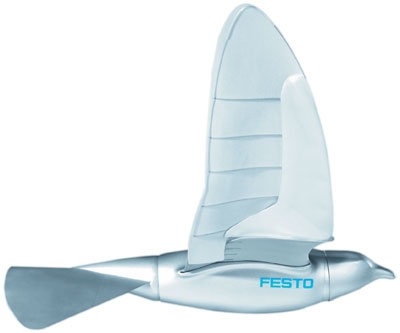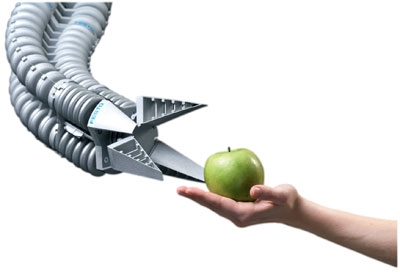It doesn’t sound much like a seagull, and its eyes glow blue in a most disconcerting fashion, but it’s just as alarming when it flies too close to you. Festo’s SmartBird technically an ornithopter flaps and swoops its way around a large, empty hall at the company’s Budapest manufacturing plant before crashing, slightly ignominiously, at the feet of its controller. ’It really needs a little more height,’ he says, apologetically.

Most industrial equipment companies are fairly anonymous when it comes to their public profile, and seemingly happy to be so. But Festo, a German automation company that specialises in pneumatic and electrical actuators, is an exception. For the past few years, it has been a regular visitor to public engagement events and has seen its name emblazoned across popular science television programmes, thanks to its growing menagerie of flying creatures. And you only have to visit one of these events to see the effect that SmartBird and its older siblings the graceful, gliding AirPenguins and AirJelly have on people. Watching an AirPenguin swooping down to hover, nose to nose, with a rapt small child is surprisingly affecting.
The fact that such innovations ten dto lend themselves to eye-catching demonstrations is purely a bonus
But the flying machines aren’t simply attention-gathering devices or gimmicks. For Festo, they’re a route to developing new forms of automation for specialised duty and an important way to investigate and capture niche markets, according to executive board member Ansgar Kriwet.
SmartBird et al were devised by a small division within Festo the Bionic Learning Network (BLN). Operating as a series of collaborations with universities, including the Massachusetts Institute of Technology (MIT), Cornell, Delft, Berlin and Stuttgart, the BLN is particularly focused on developing lightweight industrial robots; current robots are too heavy for humans to interact with safely, according to the company. The goal of the BLN is ’to combine the best of pneumatics, mechatronics, robotics and additive manufacturing’ to create new forms of robotic device, generally derived from nature, which can then be deployed in sectors where humans might need to operate closely with machines.
The target industries for these devices tend to be ones where careful handling of objects is also necessary. Festo has earmarked the handling industry, agriculture, the packaging industry, assisted living and other ’household robots’. The fact that such innovations tend to lend themselves well to eye-catching demonstration units is purely a bonus.
Among the BLN projects are two particular technologies: fluidic muscle and the fin-ray effect. The fluidic muscle is a variant of a pneumatic drive, consisting of a hollow cylinder made from a stretchy polymer, in which fibres of an aramid material a very strong polymer, of which Kevlar is the best known are embedded. When the tube fills with air, it increases in diameter but shrinks in length, creating a fluid, elastic movement that is similar in character and speed to the way that human muscles move. According to Festo, fluidic muscles can exert 10 times the force of a comparably sized pneumatic cylinder and can be used under extreme conditions involving sand and dust.
The fin-ray effect, which is a key operating principle for most of Festo’s menagerie, is an attempt to copy a property of the physiology of fish. If a lateral force is applied to a fish fin, it doesn’t bend away, but instead bulges out in the direction of the applied force. This allows the fish to deploy the full strength of its fin movements in water. A fin-ray effect unit is made from two fixed struts, joined at their tips, forming an acute triangle; these struts are connected along their length by ribs that hold them apart but allow the whole assembly to bend.
Fluidic muscles can exter ten times the force of a comparatively sized pneumatic cylinder
Combining these two devices forms the basic function of the flying robots; a fin-ray unit moved by a fluidic muscle makes a flexible, smoothly moving wing that can propel a streamlined body through air or water, hence the AirPenguin and the water-going Airacuda (which looks like a barracuda). An adapted version, which can also twist as it flaps, forms the wings of SmartBird the only one of the flying circus that is heavier than air.
But what of the real-world applications? For Festo, the fin-ray effect could best be deployed as the fingers of a gripper to handle irregular, fragile articles such as fruit.

The company has developed a system called BionicTripod. This features a gripper constructed from three fin-ray units, mounted on a ball-and-socket joint to give it wrist-like movement, and a tripod system formed from six fibreglass rods, three of which are driven and three of which act as reinforcement.
The advantages of lightweight robotics such as this include the ability to handle objects with complex shapes, as the flexible grippers conform to the shape of the object. Moreover, the motors do not need to shift much weight, reducing the energy consumption.
Another innovation derived from the programme is a milking robot, which gives the cows themselves control over when they want to be milked. If it wants to, the cow walks into a milking stall where various sensors measure its weight and size. A pneumatic arm, equipped with a laser sensor to detect the position of the udder, then moves in, and a milking unit on its tip performs the necessary function. The combination of pneumatics and electrics means that the arm can move with the cow, preventing injury.
Kriwet hopes that such innovations will provide Festo and its clients, the machine builders, with a set of components that could help to solve a pressing problem the need to grow enough food to feed the world’s growing population. This, he said, will require the developments of harvesting robots to gather in crops quickly and efficiently, but without damaging them. ’Harvesting robots will speed up agriculture,’ said Kriwet.
Moreover, lightweight mechatronics such as those developed by the BLN will help in the design of energy-efficient transport. ’Bodies for ultra-light electric and hybrid vehicles will be produced on 3D printers, and low-cost printed electronics will appear in consumer products,’ he added.
thedata
the festo menagerie
Festo’s eye-catching flying robots are designed to be lightweight and efficient
SmartBird: A 2m-wingspan, 450g flyer designed to mimic a seagull. Using about 23W of power, the bird has up to 80 per cent aerodynamic efficiency. Each two-part wing flaps up and down and twists simultaneously, while the head and tail provide steering.
AirPenguin: A 1m3 helium-filled ’ballonet’ equipped with fin-ray structures at either end, formed from four carbon rods connected at joints by a series of rings. These move in three dimensions, changing the aerodynamics of the ballonet and acting as a steering system. The wings can be positioned to provide forwards, upwards and downwards thrust.
Airacuda: A fish-shaped remote-controlled robot combining fluidic muscle and fin-ray structures. It uses four actuators to provide a full range of movement.
AirJelly: Another flyer based on a helium-filled balloon. It uses a series of carbon-fibre cranks to move eight paddle-ended tentacles, each of which is a fin-ray structure. These move backwards and forwards in a peristaltic motion, providing thrust and steering.

Red Bull makes hydrogen fuel cell play with AVL
Many a true word spoken in jest. "<i><b>Surely EVs are the best solution for motor sports</b></i>?" Naturally, two electric motors demonstrably...